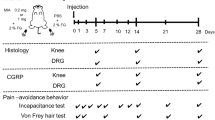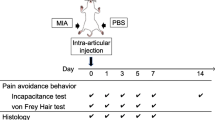Abstract
Inflammation and the related acidity in peri-articular structures may be involved in pain generation and hyperalgesia in knee osteoarthritis. This study investigated pain and associated hyperalgesia provoked by infusion of acidic saline into the infrapatellar fat pad. Twenty-eight subjects participated in two sessions in which acidic saline (AS, pH 5) or neutral saline (NS, pH 7.4) were infused into the infrapatellar fat pad for 15 min. Pain intensity, pain area, mechanical and thermal sensitivity, and maximal voluntary knee extension force were recorded. Repeated infusions were performed in 14 subjects. Infusion of AS caused significantly higher pain intensity, larger pain areas, induced hyperalgesia around the infused knee, and reduced extension force. No significant pain facilitation or spreading of hyperalgesia was found after repeated infusions as compared with single infusions. Acidic saline infused into the infrapatellar fat pad provoked pain and localized mechanical hyperalgesia. Thus, this acid-induced pain model may mimic the early-stage responses to tissue injury of knee osteoarthritis.








Similar content being viewed by others
References
Ahmad S, Dahllund L, Eriksson AB, Hellgren D, Karlsson U, Lund PE, Meijer IA, Meury L, Mills T, Moody A, Morinville A, Morten J, O’donnell D, Raynoschek C, Salter H, Rouleau GA, Krupp JJ (2007) A stop codon mutation in SCN9A causes lack of pain sensation. Hum Mol Genet 16:2114–2121
Arendt-Nielsen L, Nie H, Laursen MB, Laursen BS, Madeleine P, Simonsen OH, Graven-Nielsen T (2010) Sensitization in patients with painful knee osteoarthritis. Pain 149:573–581
Bartley EJ, Fillingim RB (2013) Sex differences in pain: a brief review of clinical and experimental findings. Br J Anaesth 111:52–58
Castrillon EE, Cairns B, List T, Svensson P, Ernberg M (2013) Acidic saline-induced pain as a model for experimental masseter myalgia in healthy subjects. Eur J Pain 17:1438–1746
Cepeda MS, Tzortzopoulou A, Thackrey M, Hudcova J, Arora Gandhi P, Schumann R (2010) Adjusting the pH of lidocaine for reducing pain on injection. Cochrane Database Syst Rev 12:1–65
Chen J, Kang D, Xu J, Lake M, Hogan JO, Sun C, Walter K, Yao B, Kim D (2013) Species differences and molecular determinant of TRPA1 cold sensitivity. Nat Commun 4:2501. https://doi.org/10.1038/ncomms3501
Clockaerts S, Bastiaansen-Jenniskens YM, Runhaar J, Van Osch GJ, Van Offel JF, Verhaar JA, De Clerck LS, Somville J (2010) The infrapatellar fat pad should be considered as an active osteoarthritic joint tissue: a narrative review. Osteoarthr Cartil 18:876–882
Cohen SP, Christo PJ, Wang S, Chen L, Stojanovic MP, Shields CH, Brummett C, Mao J (2008) The effect of opioid dose and treatment duration on the perception of a painful standardized clinical stimulus. Reg Anesth Pain Med 33:199–206
Courtney CA, O’Hearn MA, Hornby TG (2012) Neuromuscular function in painful knee osteoarthritis. Curr Pain Headache Rep 16:518–524
Da Silva LF, De Santana JM, Sluka KA (2010) Activation of NMDA receptors in the brainstem, rostral ventromedial medulla, and nucleus reticularis gigantocellularis mediates mechanical hyperalgesia produced by repeated intramuscular injections of acidic saline in rats. J Pain 11:378–387
Dieppe PA (2005) Relationship between symptoms and structural change in osteoarthritis: what are the important targets for therapy? J Rheumatol 32:1147–1149
Drewes AM, Helweg-Larsen S, Petersen P, Brennum J, Andreasen A, Poulsen H, Jensen TS (1993) McGill Pain Questionnaire translated into Danish: experimental and clinical findings. Clin J Pain 9:80–87
Ernberg M, Castrillon EE, Ghafouri B, Larsson B, Gerdle B, List T, Svensson P (2013) Experimental myalgia induced by repeated infusion of acidic saline into the human masseter muscle does not cause the release of algesic substances. Eur J Pain 17:539–550
Felson DT (2005) The sources of pain in knee osteoarthritis. Curr Opin Rheumatol 17:624–628
Fingleton C, Smart K, Moloney N, Fullen BM, Doody C (2015) Pain sensitization in people with knee osteoarthritis: a systematic review and meta-analysis. Osteoarthr Cartil 23:1043–1056
Frank SG, Lalonde DH (2012) How acidic is the lidocaine we are injecting, and how much bicarbonate should we add? Can J Plast Surg 20:71–74
Frey LA, Sluka KA, McMullen T, Lee J, Arendt-Nielsen L, Graven-Nielsen T (2008) Acidic buffer induced muscle pain evokes referred pain and mechanical hyperalgesia in humans. Pain 140:254–264
Garber K (2003) Why it hurts: researchers seek mechanisms of cancer pain. J Natl Cancer Inst 95:770–772
Gautam M, Benson CJ, Ranier JD, Light AR, Sluka KA (2012) ASICs do not play a role in maintaining hyperalgesia induced by repeated intramuscular acid injections. Pain Res Treat 817347. https://doi.org/10.1155/2012/817347
Graven-Nielsen T, Arendt-Nielsen L (2010) Assessment of mechanisms in localized and widespread musculoskeletal pain. Nat Rev Rheumatol 6:599–606
Graven-Nielsen T. Siegfried Mense S, Arendt-Nielsen L (2004) Painful and non-painful pressure sensations from human skeletal Muscle. Exp Brain Res 159:273–283
Hendiani JA, Westlund KN, Lawand N, Goel N, Lisse J, McNearney T (2003) Mechanical sensation and pain thresholds in patients with chronic arthropathies. J Pain 4:203–211
Henriksen M, Rosager S, Aaboe J, Graven-Nielsen T, Bliddal H (2011) Experimental knee pain reduces muscle strength. J Pain 12:460–467
Hill CL, Hunter DJ, Niu J, Clancy M, Guermazi A, Genant H, Gale D, Grainger A, Conaghan P, Felson DT (2007) Synovitis detected on magnetic resonance imaging and its relation to pain and cartilage loss in knee osteoarthritis. Ann Rheum Dis 66:1599–1603
Hirata RP, Arendt-Nielsen L, Shiozawa S, Graven-Nielsen T (2012) Experimental knee pain impairs postural stability during quiet stance but not after perturbations. Eur J Appl Physiol 112:2511–2521
Hodges PW, Mellor R, Crossley K, Bennell (2009) Pain induced by injection of hypertonic saline into the infrapatellar fat pad and effect on coordination of the quadriceps muscles. Arthritis Rheum 61:70–77
Hoeger-Bement MK, Sluka KA (2003) Phosphorylation of CREB and mechanical hyperalgesia is reversed by blockade of the cAMP pathway in a time-dependent manner after repeated intramuscular acid injections. J Neurosci 23:5437–5445
Hood VL, Chubert C, Keller U, Muller S (1988) Effect of systemic pH on pHi and lactic acid generation in exhaustive forearm exercise. Am J Physiol 255:F479-F485
Hortobagyi T, Garry J, Holbert D, Devita P (2004) Aberrations in the control of quadriceps muscle force in patients with knee osteoarthritis. Arthritis Rheum 51:562–569
Hunt SP (2009) Genes and the dynamics of pain control. Funct Neurol 24:9–15
Ikeuchi M, Kolker SJ, Burnes LA, Walder RY, Sluka KA (2008) Role of ASIC3 in the primary and secondary hyperalgesia produced by joint inflammation in mice. Pain 137:662–669
Issberner U, Reeh PW, Steen KH (1996) Pain due to acidosis: a mechanism for inflammatory and ischemic myalgia? Neurosci Lett 208:191–194
Jinks C, Jordan K, Croft P (2007) Osteoarthritis as a public health problem: the impact of developing knee pain on physical function in adults living in the community: (KNEST 3). Rheumatology 46:877–881
Joergensen TS, Henriksen M, Danneskiold-Samsoe B, Bliddal H, Graven-Nielsen T (2013) Experimental knee pain evoke spreading hyperalgesia and facilitated temporal summation of pain. Pain Med 14:874–883
Jones NG, Slater R, Cadiou H, McNaughton P, McMahon SB (2004) Acid-induced pain and its modulation in humans. J Neurosci 24:10974–10979
Martel MO, Wasan AD, Edwards RR (2013) Sex differences in the stability of conditioned pain modulation (CPM) among patients with chronic pain. Pain Med 14:1757–1768
McMahon SB, Jones NG (2004) Plasticity of pain signaling: role of neurotrophic factors exemplified by acid-induced pain. J Neurobiol 61:72–87
Messier SP, Loeser RF, Hoover JL, Semble EL, Wise CM (1992) Osteoarthritis of the knee: effects on gait, strength, and flexibility. Arch Phys Med Rehabil 73:29–36
Mista CA, Salomoni SE, Graven-Nielsen T (2014) Spatial reorganisation of muscle activity correlates with change in tangential force variability during isometric contractions. J Electromyogr Kinesiol 24: 37–45
Roche-Gonzalez HI, Herrejon-Abreu E, Lopez-Santillan FJ, Garcia-Lopez BE, Murbartian J, Granados-Soto V (2009) Acid increase inflammatory pain in rats: effect of local peripheral ASICs inhibitors. Eur J Pharmacol 603:56–61
Rolke R, Baron R, Maier C, Tolle TR, Treede RD, Beyer A et al (2006) Quantitative sensory testing in the German Research Network on Neuropathic Pain (DFNS): standardized protocol and reference values. Pain 123:231–243
Rukwied R, Chizh BA, Lorenz U, Obreja O, Margarit S, Schley M, Schmelz M (2007) Potentiation of nociceptive responses to low pH injections in humans by prostaglandin E2. J Pain 8:443–451
Salomoni SE, Graven-Nielsen T (2012a) Experimental muscle pain increases normalized variability of multidirectional forces during isometric contractions. Eur J Appl Physiol 112:3607–3617
Salomoni SE, Graven-Nielsen T (2012b) Muscle fatigue increases the amplitude of fluctuations of tangential forces during isometric contractions. Hum Mov Sci 31:758–771
Schaible HG (2012) Mechanisms of chronic pain in osteoarthritis. Curr Rheumatol Rep 14:549e56
Schaible HG, Ebersberger A, Von Banchet GS (2002) Mechanisms of pain in arthritis. Ann N Y Acad Sci 966:343–354
Skyba DA, Lisi TL, Sluka KA (2005) Excitatory amino acid concentrations increase in the spinal cord dorsal horn after repeated intramuscular injection of acidic saline. Pain 119:142–149
Sluka KA, Kalra A, Moore SA (2001) Unilateral intramuscular injections of acidic saline produce a bilateral, long-lasting hyperalgesia. Muscle Nerve 24:37–46
Sluka KA, Price MP, Breese NM, Stucky CL, Wemmie JA, Welsh MJ (2003) Chronic hyperalgesia induced by repeated acid injections in muscle is abolished by the loss of ASIC3, but not ASIC1. Pain 106:229–239
Sluka KA, Radhakrishnan R, Benson CJ, Eshcol JO, Price MP, Babinski K et al (2007) ASIC3 in muscle mediates mechanical, but not heat, hyperalgesia associated with muscle inflammation. Pain 129:102–112
Steen KH, Reeh PW (1993) Sustained graded pain and hyperalgesia from harmless experimental tissue acidosis in human skin. Neurosci Lett 154:113–116
Tillu DV, Gebhart GF, Sluka KA (2008) Descending facilitatory pathways from the RVM initiate and maintain bilateral hyperalgesia after muscle insult. Pain 136:331–339
Acknowledgements
This study was funded by The Danish Rheumatism Association, The Danish National Advanced Technology Foundation, Aase and Ejnar Danielsen’s Foundation, Lions Club Denmark, and The Danish Council for Technology and Innovation (09-052174). The authors thank professor Brian Edwin Cairns for proofreading the manuscript.
Author information
Authors and Affiliations
Corresponding author
Ethics declarations
Conflict of interest
The authors declare no conflict of interest.
Rights and permissions
About this article
Cite this article
Asaki, T., Wang, K., Luo, Y. et al. Acid-induced experimental knee pain and hyperalgesia in healthy humans. Exp Brain Res 236, 587–598 (2018). https://doi.org/10.1007/s00221-017-5155-5
Received:
Accepted:
Published:
Issue Date:
DOI: https://doi.org/10.1007/s00221-017-5155-5




